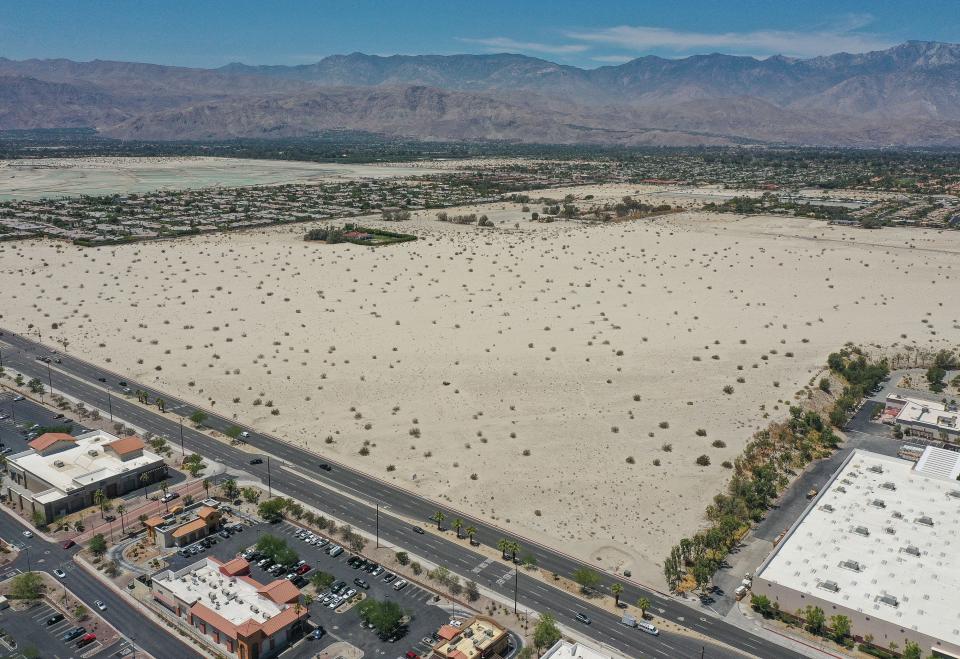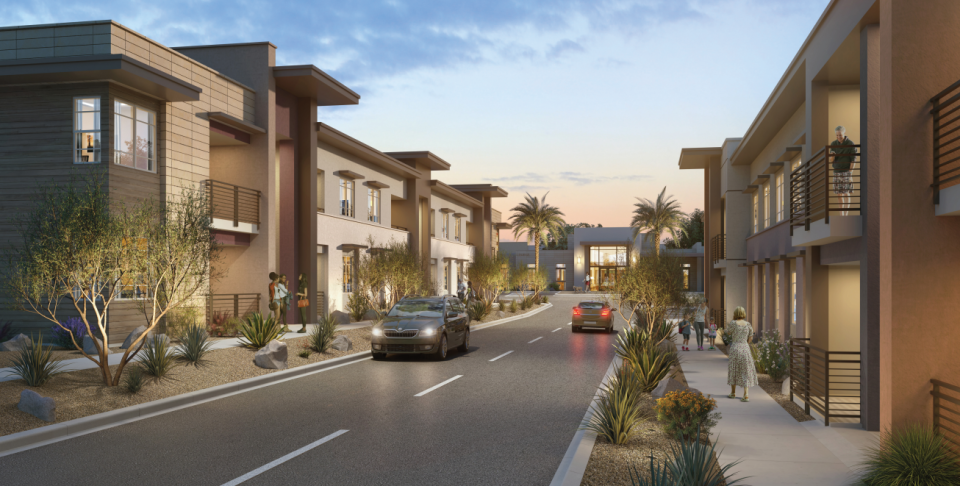Rancho Mirage council OKs plan for 234 affordable apartments
With the backing of business leaders who described an urgent need for more housing in Rancho Mirage for hotel and hospital workers, the city council has approved a 234-unit affordable housing project near Gerald Ford Drive and Monterey Avenue.
Known as Via Vail Apartments, the project approved last week is planned for 10 acres of vacant land just south of the Regal Rancho Mirage movie theater and just east of the city’s dog park.
The proposed development comes from Pacific West Communities Inc., which has similar projects in the works in Indio and Palm Desert, and it’s one of three affordable housing projects that could eventually be developed on about 25 acres of land just west of Monterey Avenue.

Late last year, the council approved agreements with several housing developers to eventually turn four parcels, including three near the dog park, into affordable housing. Via Vail Apartments was the first of those three to gain final approval, while the council also recently approved a development near Rancho Mirage High School that includes 94 affordable apartments.
Once completed, the new projects would mark the city's first affordable housing development in over a decade: The most recent to be completed was the San Jacinto Villas, an 82-unit apartment complex for those 55 and up that opened in 2011, according to the city's Housing Element. (In 2018, the city also extended an affordability covenant through 2060 for the Rancho Mirage Villa Apartments, a 35-unit privately owned 55-plus complex that was at risk of moving to market rates.)
More: Rancho Mirage's planned Catana development to include 200 houses, nearly 100 apartments
What's in the project?
The Via Vail Apartments, which features 15 two-story buildings, is slated to include a mix of one-bedroom, two-bedroom and three-bedroom units, along with a pool, a community room, a fitness room and a tot lot. It also includes two units set aside for on-site building managers.
The discounted apartments will only be available to people making between 30% and 80% of the area median income in Riverside County — or no more than $82,000 for a four-member household, according to state income limits issued this year.
The project is tentatively slated for completion in 2027. Lauren Alexander, an official with Pacific West Communities, said they’re aiming to have permits in place to begin construction by summer 2025, and the team expects the project will take another two years to be built.

Alexander said the complex will also offer certain services for its residents that will be decided later as the developer prepares for leasing, though she mentioned health and wellness classes, homebuyer education, resume building and opportunities for people to gain GED diplomas as some possibilities.
As part of its approval at the meeting July 18, the council also agreed to defer all of the city’s development impact fees, estimated at roughly $1.8 million, to be repaid over time once the project is built.
The project's main entry will be through an extension of Via Vail at its southeast end, along with a secondary access point at the northwest end of the property. Plans for the apartments also mention the possibility of a future 25-acre community park to the west of the project running along Key Largo Avenue.
Business officials underscore housing need
A couple of representatives from the city’s business community urged the council to advance the project during the meeting, echoing comments from hospitality officials during the council's earlier discussions of the site near Monterey Avenue.
David Kowalczyk, the vice president of human resources at Eisenhower Health and a board member of the Rancho Mirage Chamber of Commerce, underscored the need for more affordable housing as Eisenhower continues to add to its workforce of roughly 4,800.
“We have a large number of employees who have lower incomes and find it challenging to find affordable housing, especially near our main campus,” Kowalczyk said. “Additionally, we know from recruitment feedback that a lack of affordable housing is a major barrier to recruitment, especially from out-of-state recruits.”
Michael Murgas, the director of sales and marketing at Omni Rancho Las Palms Resort & Spa, described approving the project as “the most business-friendly move the city can make,” and he thanked for city for its work on the development, as well as the recently approved Catana project near the city's high school.
“We are constantly hearing from our constituents that being able to attract the best employees is critical to their business,” said Murgas, who is also on the chamber of commerce board. “A project like this allows 230 opportunities for qualified applicants to work and live in the city that they make so desirable.”
What the council said
Members of the council were in broad agreement about the urgent need for affordable housing, as they unanimously approved the project.
Councilmember Lynn Mallotto said she and her colleagues heard the pleas for more affordable housing from hotel and hospital officials, adding the state’s dissolving of city-run redevelopment agencies in 2012 made it much harder to build such projects.
“I was a former (redevelopment agency) employee at the city of Cathedral City,” Mallotto said. “It was much easier then. You had public-private partnerships. ... Whatever the community needed, that was available with state funds and also federal housing funds to make these developments and housing tracts available to our workforce. Needless to say, the mandate is still there by the state of California, but the funding has diminished completely.”
She also credited the city’s staff for getting the agreements in place late last year, ahead of a looming deadline. By locking in the agreement, the city managed to keep the parcel's "high resource" designation — enabling the developer to access more state funds and other tax incentives to build there — before it was changed by a state tax committee in January.
Mayor Pro Tem Ted Weill said he thought the project looks great, saying the city is “moving in the right direction” toward meeting its affordable housing goals set by its state-mandated Housing Element. For the current eight-year cycle, the city's approved plan outlines a need for roughly 1,741 new homes, including 1,076 for people with very low-to-moderate income levels. Weill said the city has already approved plans for nearly 2,300 homes in this cycle, but he did not say how many are for moderate- or low-income people.
Tom Coulter covers the cities of Palm Desert, La Quinta, Rancho Mirage and Indian Wells. Reach him at thomas.coulter@desertsun.com.
This article originally appeared on Palm Springs Desert Sun: Rancho Mirage council OKs 234-unit affordable housing plan

